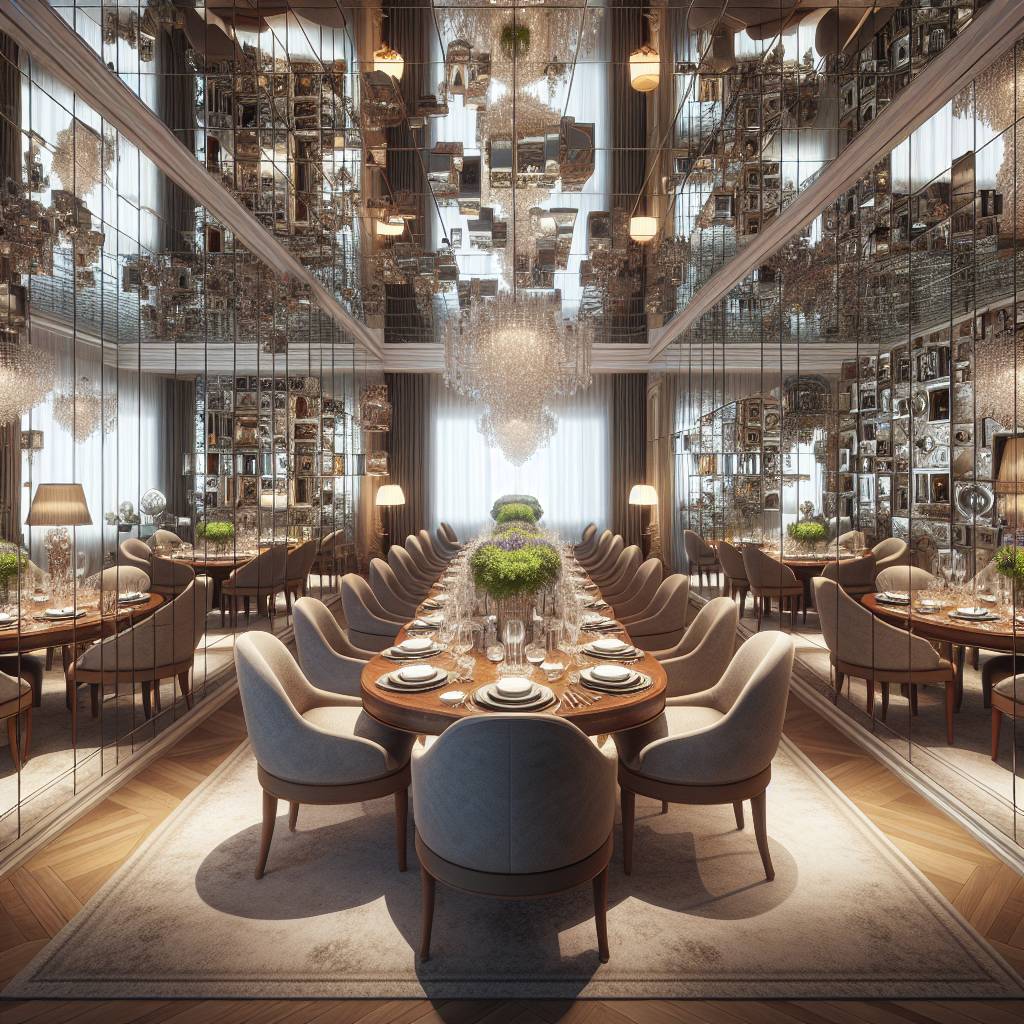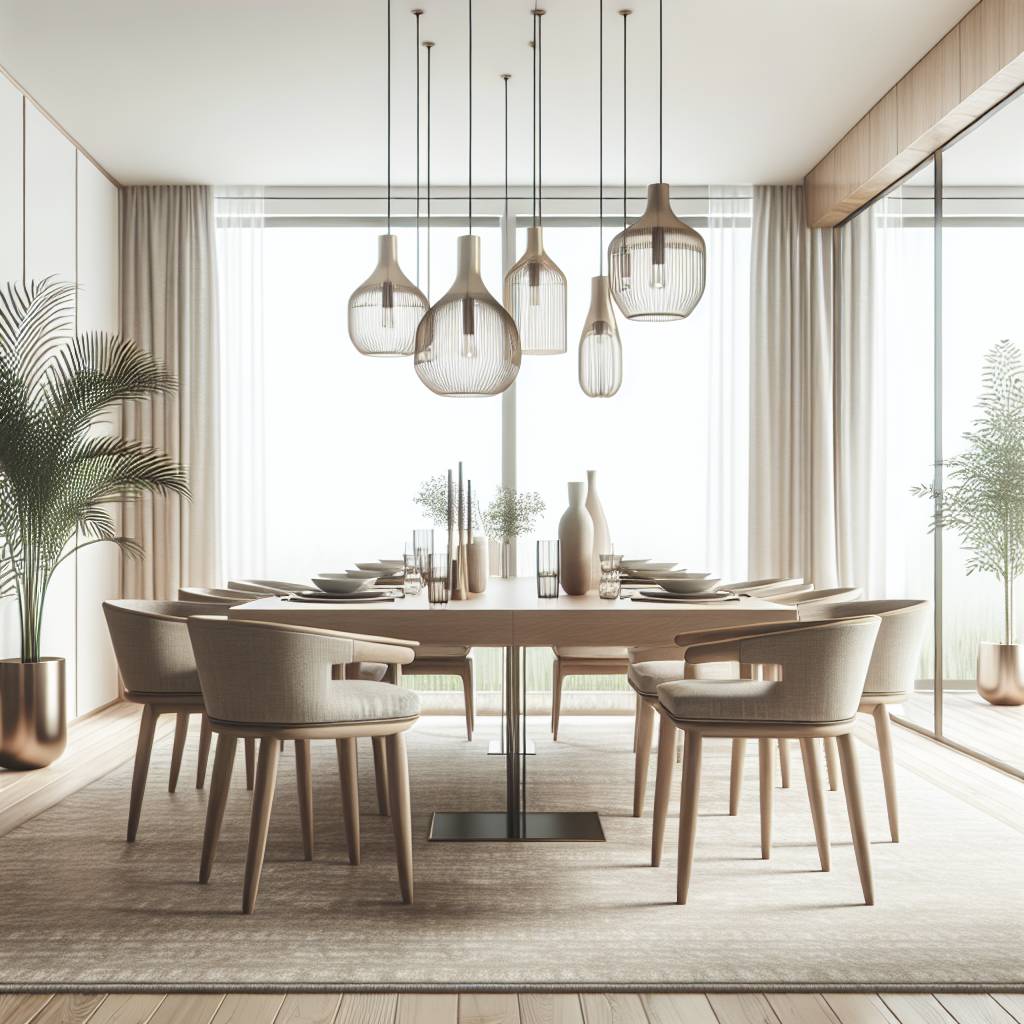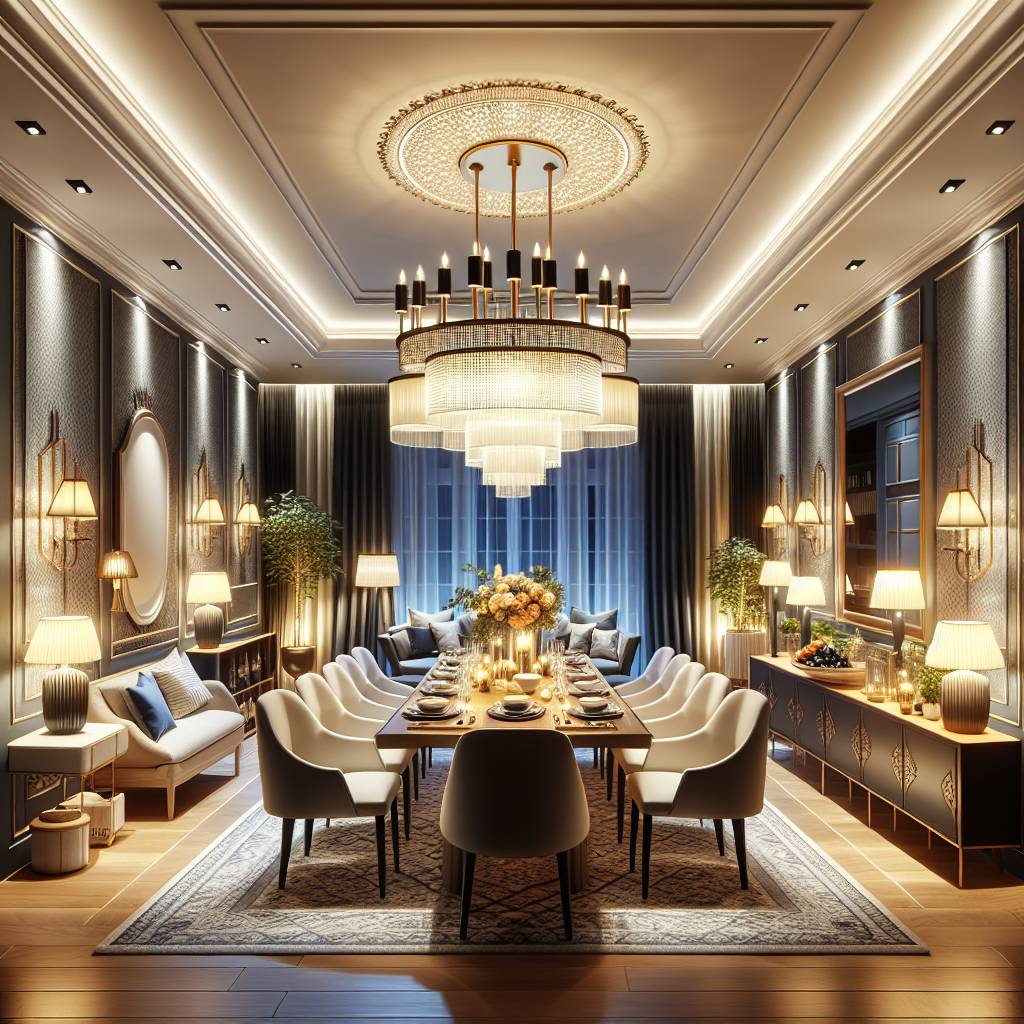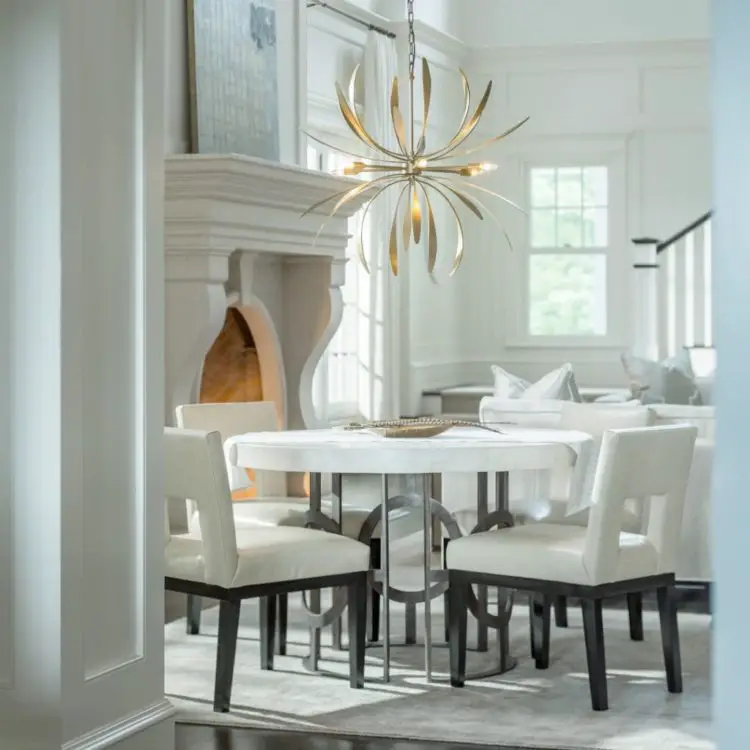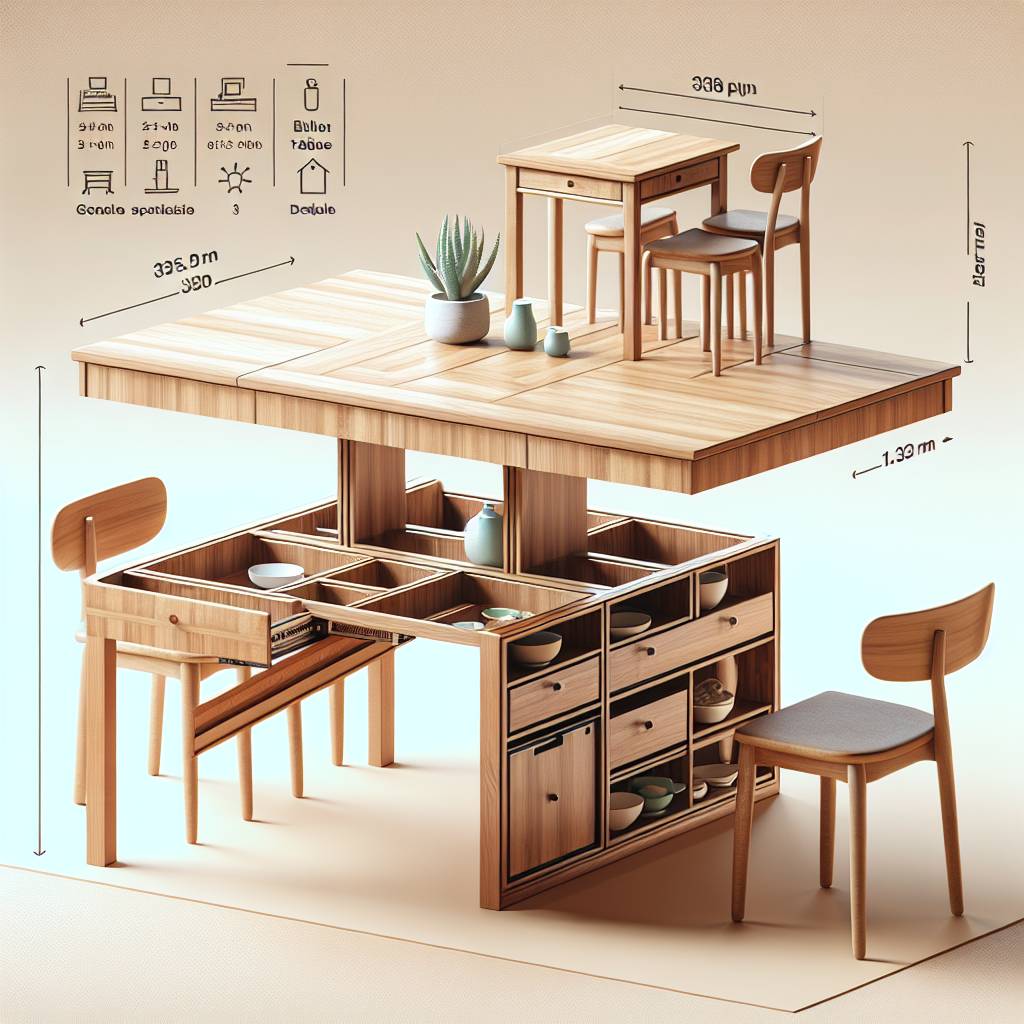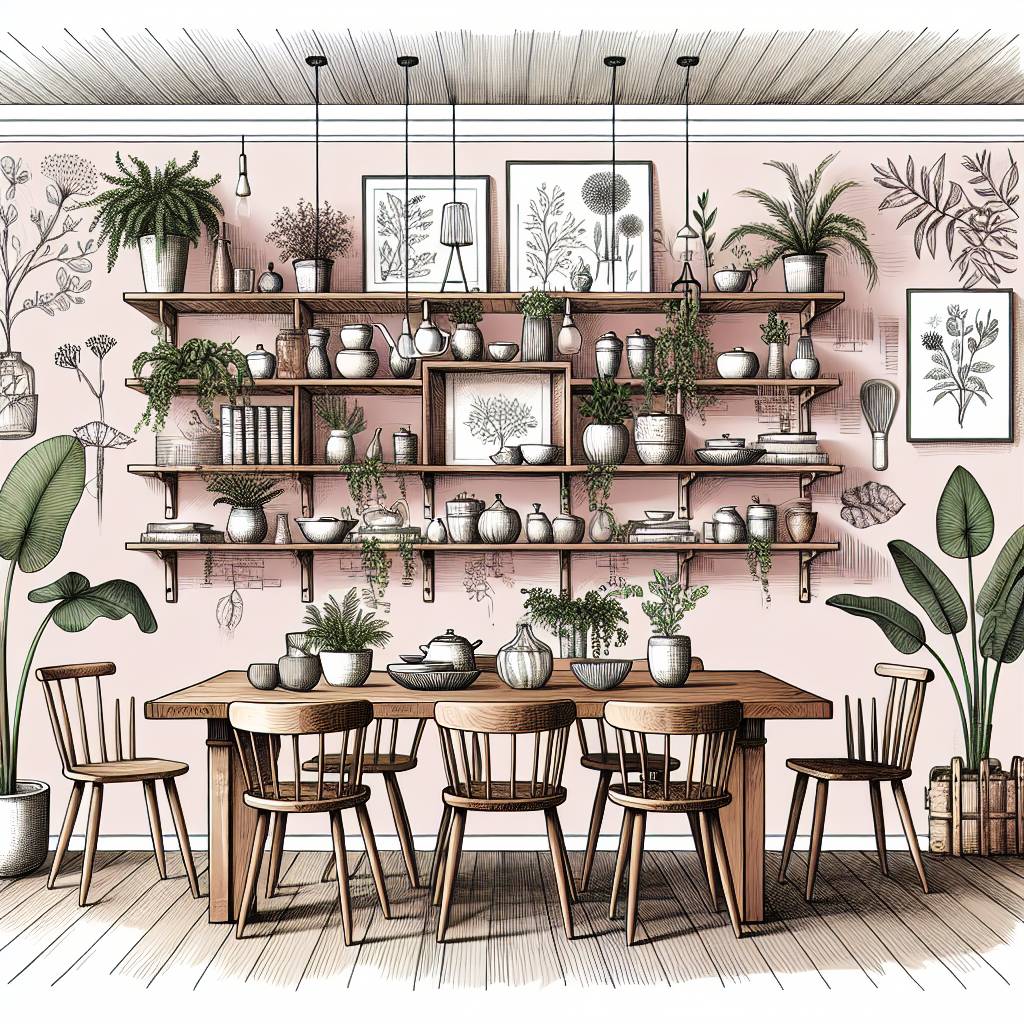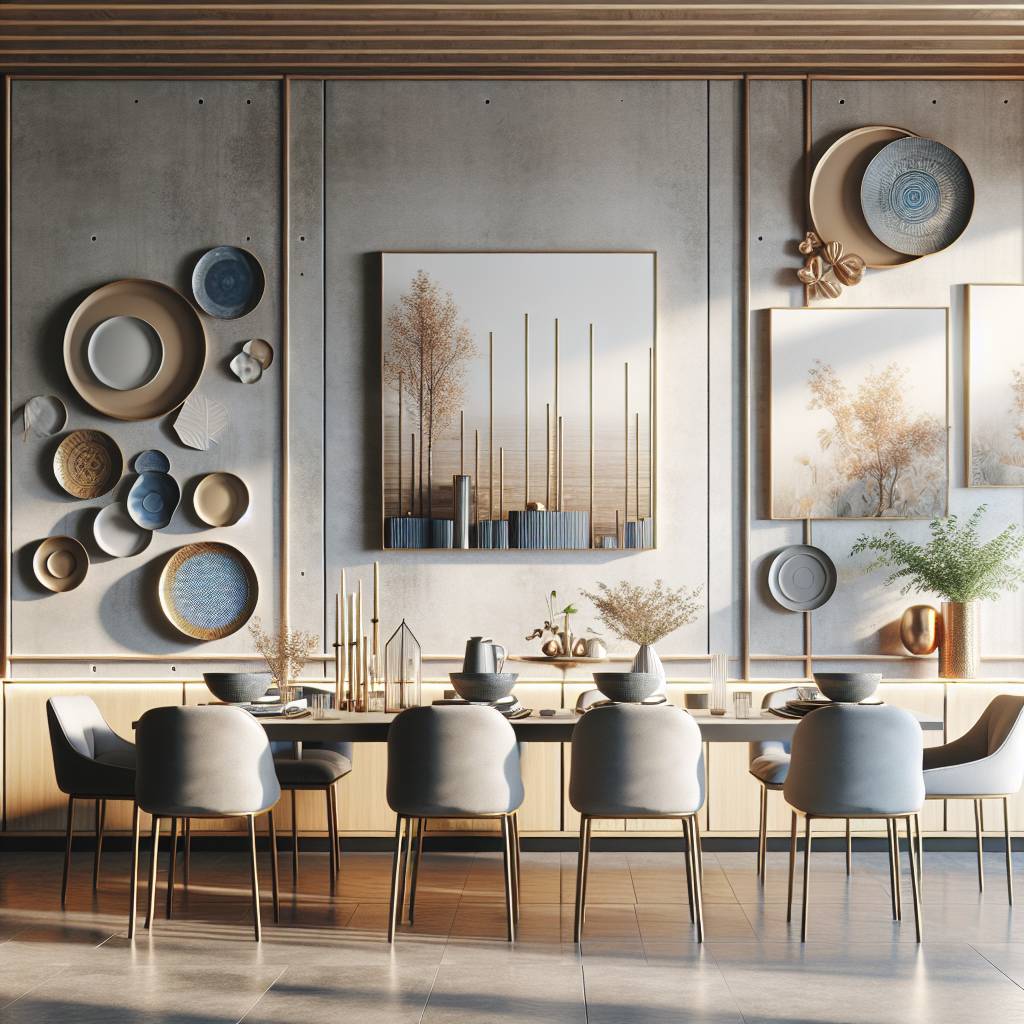Want to transform your dining room into a spacious, inviting area without knocking down any walls? By strategically placing mirrors, you can instantly amplify the perceived size of your dining space. Imagine enjoying meals in a room that feels double its actual size – that’s the magic mirrors can bring.
In this post, we’ll dive into the art of using mirrors to create an illusion of space in dining rooms. From choosing the right mirror sizes and placements to maximizing natural light reflection, we’ve got you covered. Say goodbye to cramped dining areas and hello to an open, airy ambiance with just a few cleverly positioned mirrors.
Key Takeaways
- Strategic placement of mirrors in dining rooms can create the illusion of space and add depth to the area, making it feel more open and inviting.
- When choosing a mirror for your dining room, consider the size, shape, and frame to complement the existing decor and maximize the visual impact.
- To maximize the space-enhancing effects of mirrors, place them across from windows or light sources to reflect natural light and brighten the room.
- Avoid common decorating mistakes such as placing mirrors in cluttered or busy areas, which can create visual chaos instead of the desired spacious effect.
- In small dining areas, opt for smaller or multiple mirrors to avoid overpowering the space while still achieving the illusion of a larger room.
- Combining mirrors with other elements such as lighting fixtures, artwork, or furniture can further enhance the aesthetic appeal and functionality of the dining room.
The Magic of Mirrors
Visual Expansion
Mirrors can work wonders in creating the illusion of a larger dining area. By strategically placing mirrors, you can make your dining room feel more spacious and enhance the ambiance. Reflective surfaces play with perception and visually expand the space, making it appear bigger than it actually is. For instance, a large mirror on one wall can give the impression that there’s an entire other side to the room.
Another way mirrors help is by reflecting light into different parts of the room, thus brightening up dark corners and creating a sense of openness. This visual trickery makes them an excellent tool for maximizing small spaces.
Light Reflection
One remarkable benefit of incorporating mirrors into your dining room decor is their ability to reflect natural and artificial light, effectively enhancing the overall lighting in the space. Placing mirrors opposite windows or light fixtures allows them to bounce light around, brightening even dimly lit areas.
Imagine how this would transform your dinner parties—soft candlelight reflected in multiple directions by well-placed mirrors on dining room walls could create a warm and inviting atmosphere for your guests.
Focal Points
In addition to their functional advantages, mirrors also have aesthetic benefits as they serve as striking focal points in dining room decor. A statement mirror above a buffet or console table can become an eye-catching centerpiece that draws attention upon entering the room.
By using carefully chosen decorative frames or unique shapes, you can further emphasize these focal points while adding personality and style to your dining area through clever use of reflective surfaces.
Style and Function
When selecting mirrors for dining room walls, it’s essential to consider both style and functionality. Choose options that not only complement but also enhance the design aesthetic of your dining room. Whether you opt for sleek modern designs or ornate vintage styles, ensure they blend seamlessly with existing decor elements.
Moreover, look for mirrors that offer practical value beyond just aesthetics—a full-length mirror near the entrance provides functionality while contributing to visual expansion at the same time.
Benefits of Mirrors in Dining Rooms
Illusion of Space
Mirrors can work wonders in creating the illusion of a more spacious dining room. By strategically placing mirrors on the dining room walls, you can make the space appear larger and airier than it actually is. When natural light or artificial lighting reflects off these mirrors, it creates a sense of depth and openness, giving the impression that the dining area extends beyond its physical boundaries. For instance, if your dining room feels cramped or lacks windows to let in natural light, adding a large mirror to one wall can instantly make the space feel bigger.
Using mirrors to visually expand the perceived size of the dining room is an effective way to transform a small or narrow area into a more inviting and comfortable space for entertaining guests. Just by incorporating well-placed mirrors into your dining room decor, you can achieve this visual trickery without any major renovations.
Enhanced Lighting
Another remarkable benefit of utilizing mirrors in dining rooms is their ability to enhance both natural and artificial lighting within the space. Placing mirrors opposite windows allows them to reflect incoming sunlight throughout the room, brightening dark corners and making even windowless areas feel sunnier. Moreover, when strategically positioned near lamps or overhead lighting fixtures, mirrors maximize light reflection and dispersion across your entire dining area.
Imagine how much brighter your dinner parties could be with this simple addition! Whether during daytime gatherings where sunlight fills your home or at evening events when artificial lights take over, properly positioned mirrors on dining room walls will help amplify these sources of illumination for an overall radiant effect.
Aesthetic Appeal
Beyond their functional advantages related to creating spaciousness and enhancing lighting levels in your dining room, there’s no denying that mirrors add aesthetic appeal as well. They bring elegance and sophistication while contributing visual interest to your decor scheme.
By carefully choosing stylish frames or unique shapes for these reflective elements on your dining room walls, you have an opportunity not only to make small spaces seem grander but also elevate their overall design aesthetic significantly. The right mirror can act as a stunning focal point that complements other decorative elements like artwork or furniture pieces while adding depth and dimension through its reflective properties.
Incorporating such elegant features, like dining room walls, enhances not only how others perceive your living space but also elevates how you experience it yourself every day.
Choosing the Perfect Mirror
Size and Proportion
When using mirrors to create the illusion of space in dining rooms, size and proportion play crucial roles. It’s essential to select mirrors that are proportionate to the size of the dining space. Large mirrors can make a small dining area appear more spacious, while smaller mirrors can add depth without overwhelming a larger room. For example, in a cozy dining nook, a medium-sized mirror with an elegant frame can open up the space without dominating it.
Ensure that the chosen mirrors are appropriately sized for balanced proportions in the dining area. A good rule of thumb is to consider how much dining room wall space is available and choose a mirror that fits well within those dimensions. This way, you avoid overpowering or underwhelming the room with an ill-fitting mirror.
Shape Variations
Exploring different mirror shapes offers an opportunity to add visual interest and personality to your dining room. Incorporating varied mirror shapes such as round, oval, rectangular, or even irregularly shaped mirrors can create a dynamic and engaging look on dining room walls. For instance, placing multiple circular mirrors on one wall creates an eye-catching focal point while contributing to an eclectic ambiance.
Experimenting with diverse mirror shapes also allows for flexibility in achieving specific design goals—whether aiming for a contemporary feel through geometric forms or embracing tradition with ornate frames on classic-shaped mirrors.
Frame Styles
Selecting appropriate mirror frame styles is crucial when integrating them into your dining room decor theme. It’s important to explore various frame styles until finding one that harmonizes seamlessly with your desired aesthetic—be it modern minimalism or rustic charm.
Incorporating frames that enhance and elevate the style of your dining area contributes significantly to its overall ambiance. For instance, if you’re going for a farmhouse-inspired look in your dining room, opting for distressed wooden frames adds warmth and character; meanwhile sleek metallic frames complement contemporary settings beautifully.
Color Harmony
Choosing suitable mirror finishes helps promote color harmony within your dining room’s existing color schemes—a critical aspect when utilizing mirrors for creating spatial illusions. Ensure that mirror colors harmonize effortlessly with other elements present in the space—a gold-framed mirror might accentuate warm tones prevalent in traditional decor themes while silver-finished ones could complement cooler palettes often found in modern interiors.
Strategic Placement for Maximum Effect
Wall Positioning
Strategically positioning mirrors on the walls of a dining room is crucial to optimize their visual impact. By carefully considering wall positioning, you can maximize reflection and enhance the spatial perception in the dining area. Placing mirrors thoughtfully on walls allows you to achieve the desired visual effects, making the space appear more expansive and open.
For example, placing a large mirror opposite a window can reflect natural light into the room, creating an illusion of depth and openness. installing mirrors on adjacent or perpendicular walls can create multiple reflections that contribute to expanding the perceived space within the dining room.
Reflecting Views
Using mirrors to reflect outdoor views is a great way to bring nature into your dining room. By strategically positioning mirrors to capture and reflect scenic views from outside windows, you can introduce captivating external elements into your dining space. This not only enhances the aesthetic appeal but also creates an immersive experience for diners by connecting them with nature.
For instance, positioning a mirror across from a picturesque garden or landscape allows it to visually extend these outdoor scenes into your dining area. Similarly, reflecting an attractive feature such as a courtyard or water body through well-placed mirrors adds depth and dimension to your surroundings.
Near Lighting Sources
Mounting mirrors near lighting sources plays a significant role in enhancing illumination within the dining area. Strategically placing mirrors close to lighting fixtures amplifies brightness by effectively reflecting and dispersing light throughout the space. This not only contributes to creating a well-lit ambiance but also accentuates other design elements in the room.
Creative Ideas for Mirror Decorating
Mirror Backsplashes
Incorporate mirrored backsplashes to add depth and dimension to your dining room. These reflective surfaces behind shelves or cabinetry can create the illusion of a larger space. By strategically placing mirrored backsplashes, you can enhance the visual appeal of your dining area while also making it feel more spacious. For example, consider installing a mirrored backsplash along one wall of your dining room to instantly open up the space and make it appear brighter.
Use mirrored backsplashes as both a stylish and functional addition to your dining space. Not only do they serve as visually striking design elements, but they also contribute to creating an illusion of expanded square footage in smaller dining rooms. The reflective nature of these backsplashes bounces light around the room, making it feel airier and more expansive.
Enhance visual depth by integrating mirrored backsplashes into your dining room design. When strategically placed, these reflective surfaces can create captivating visual effects that draw attention away from any spatial constraints within the dining area. By incorporating mirrored backsplashes into specific areas such as alcoves or recessed spaces, you can amplify the feeling of depth within the room.
Cohesive Pairings
Pair multiple matching or complementary mirrors for a cohesive look in your dining area. By selecting mirrors with similar frames or shapes, you can achieve a unified aesthetic that ties together the entire space seamlessly. For instance, hanging two identical round mirrors on adjacent walls creates symmetry and balance in the room.
Create a unified design by pairing mirrors that share similar styles or themes throughout your dining area. Whether it’s through coordinating colors or complementary designs, cohesive pairings of mirrors bring harmony to the overall decor scheme in your dining space.
Incorporate cohesive pairings of mirrors for a harmonious visual impact in your dining space; this approach ensures that each mirror complements others without overwhelming the room with disjointed elements.
Statement Pieces
Make a bold statement with large, ornate mirrors as focal points in your dining room; their grandeur draws attention and adds an element of elegance to the space. Introduce dramatic flair with statement-making oversized mirrors on feature walls within your dining area, creating an eye-catching centerpiece that contributes to an atmosphere of sophistication. Elevate your dining area’s design with impactful statement pieces through carefully chosen *
Maximizing Space with Mirrors
Small Mirrors, Big Impact
Incorporate small, strategically placed mirrors for significant visual impact in your dining space. By using several small decorative mirrors on one wall, you can create the illusion of depth and make the room feel more spacious. These mirrors reflect light and add a sense of airiness to the dining area.
Achieve big design results by using small, artfully positioned decorative mirrors. For example, placing a collection of small round or square mirrors in different sizes and styles on one wall can visually expand the space. This arrangement not only adds interest but also makes the room appear larger than it actually is.
Leverage small-sized decorative mirrors for substantial influence on your overall design scheme. Placing smaller mirrors at eye level allows them to reflect various angles of the room, creating an optical illusion that gives the impression of a larger dining area.
Complementary Accents
Pair decorative accents such as sconces or artwork with strategically placed wall-mounted mirrors. By combining these elements, you can draw attention away from limited space while adding character to your dining room. For instance, flanking a large mirror with sconces creates an elegant focal point that enhances both lighting and visual appeal.
Enhance mirror placement with complementary decorative accents for an integrated look. Adding artwork around wall-mounted mirrors helps blend them seamlessly into your decor while elevating their aesthetic impact within the space.
Incorporate additional decorative elements alongside strategically positioned wall-mounted mirrors for enhanced visual appeal. Consider incorporating unique pieces like sculptural art or ornate frames around your mirrored surfaces to further amplify their ability to create an expansive atmosphere within your dining area.
Avoiding Decorating Mistakes
Overcrowding Spaces
When using mirrors to create the illusion of space in dining rooms, it’s crucial to avoid overcrowding. Placing too many mirrors can make the room feel cramped and overwhelming. Instead, strategically position mirrors to reflect light and open up the space without causing visual clutter.
For example, if you have a small dining area, consider placing a single large mirror on one wall rather than multiple smaller ones. This approach can create the illusion of depth and expansiveness without overwhelming the space.
Be mindful of not overusing or overcrowding your dining area with an excessive number of mirrors. By carefully considering mirror placement and quantity, you can maintain an open, uncluttered feel while achieving the desired spacious effect.
Inappropriate Sizing
Another common decorating mistake when using mirrors is choosing inappropriate sizing for your space. Oversized mirrors in a small dining room can dominate the area and throw off visual proportions. On the other hand, tiny mirrors in a large dining room might get lost amidst other decor elements.
To prevent awkward visual proportions and ensure proper scale and proportion, carefully consider suitable mirror dimensions for your specific space. A well-proportioned mirror will enhance the overall aesthetic appeal while contributing to an expansive atmosphere within your dining room.
Clashing Styles
Selecting mirror designs that align with your existing decor theme is essential for avoiding clashing styles when integrating different types of mirrors into your design concept. Mixing modern sleek mirrors with ornate vintage frames may disrupt visual harmony within your dining area.
To promote design cohesion and maintain visual harmony, ensure that mirror styles complement other elements in your space seamlessly. Whether it’s contemporary minimalist or classic elegance, harmonizing mirror designs with existing decor themes will contribute to a cohesive look while maximizing spatial perception through reflective surfaces.
Special Considerations for Small Dining Areas
Mirror Placement Tips
Strategic mirror placement can significantly impact the perceived spaciousness of a dining area. By positioning mirrors in specific locations, you can create an illusion of a larger space. For instance, placing a mirror opposite a window can reflect natural light and outdoor scenery, making the room feel more open and airy. Hanging mirrors on walls adjacent to light sources or chandeliers can help distribute brightness throughout the room.
Moreover, consider placing mirrors behind decorative elements such as shelves or artwork to multiply their visual presence within the dining area. This clever technique not only enhances the aesthetic appeal but also contributes to expanding the sense of space within small dining rooms.
Visual Tricks and Effects
Incorporating optical illusions through strategic use of mirrors is an effective method for enhancing perceived spaciousness in dining spaces. When strategically positioned, mirrors have the ability to visually double the size of a room by creating reflections that extend its boundaries.
One visual trick involves installing large wall-to-ceiling mirrors on one side of the dining area to give off an impression of extended depth. Another effective approach is using mirrored furniture pieces like buffets or cabinets with reflective surfaces to add depth and dimension while maintaining functionality in small dining rooms.
Combining Mirrors with Other Elements
Furniture Synergy
It’s crucial to harmonize furniture selections with mirrored elements. By curating furniture pieces that complement mirrored features, you can achieve unified interior aesthetics. For instance, pairing a sleek, glass-topped dining table with mirrored cabinets or sideboards can create a cohesive and spacious feel within the dining area. The reflective surfaces of the mirrors will bounce light around the room, making it appear larger and airier.
Selecting chairs or seating options that feature metallic accents or upholstery in soft tones can further enhance the synergy between furniture and mirrors. This careful selection contributes towards cohesive interior styling while maximizing the perceived spaciousness of the dining room.
Complementary Decorations
Pairing complementary decorations such as artwork, vases, or sculptures with strategically placed mirrored elements is another effective way to enhance small dining areas. Integrating additional decorative elements alongside mirrors not only adds visual interest but also creates balanced interior compositions. For example, hanging an eye-catching piece of artwork on a wall adjacent to a large mirror can draw attention away from limited space by creating an intriguing focal point.
Moreover, incorporating floral arrangements or decorative vases atop mirrored surfaces within dining spaces contributes to visually appealing interiors. These complementary decorations play a significant role in creating harmonious designs while amplifying the illusion of spaciousness achieved through strategic mirror placement.
Summary
Congratulations! You’ve now unlocked the secrets to using mirrors to create the illusion of space in your dining room. By strategically choosing and placing mirrors, you can maximize the visual appeal and spaciousness of your dining area. Remember to consider the size of the room and experiment with different decorative ideas to achieve the desired effect. Embrace the magic of mirrors and transform your dining space into a stunning and inviting area that feels larger than life.
Now it’s time to put these tips into action. Take a look at your dining room with fresh eyes and start planning how you can incorporate mirrors to enhance its ambiance. Whether it’s adding a statement mirror or combining them with other elements, let your creativity flow. With these insights, you’re well on your way to creating a dining room that exudes style and spaciousness.
Frequently Asked Questions
How can mirrors create the illusion of space in dining rooms?
Mirrors can create the illusion of space by reflecting light and giving the impression of a larger, more open area. Placing mirrors strategically can make a dining room feel more spacious and airy, enhancing the overall ambiance.
What are some creative ideas for mirror decorating in dining rooms?
Incorporate decorative frames or unique shapes to add visual interest. Consider using multiple smaller mirrors instead of one large piece for a contemporary look. Experiment with different hanging angles to create an artistic focal point.
Are there specific considerations for using mirrors in small dining areas?
In smaller spaces, opt for slim-profile or frameless mirrors to avoid overwhelming the room. Positioning them across from windows can amplify natural light and visually expand the area, making it feel less cramped.
Can mirrors be combined with other elements in dining room decor?
Absolutely! Pairing mirrors with items like metallic accents or statement lighting fixtures enhances their impact. Integrating reflective surfaces such as glass tabletops or glossy finishes complements mirror usage while adding depth to the design scheme.
What are some common decorating mistakes to avoid when using mirrors in dining rooms?
Avoid placing mirrors where they directly reflect cluttered areas or unflattering views. Overdoing it with too many large mirrors can also backfire by creating an overly busy atmosphere rather than enhancing spaciousness.
